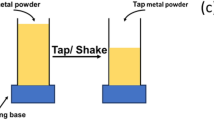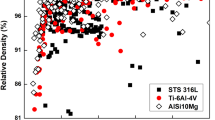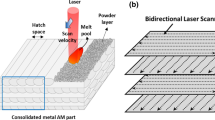Abstract
Laser powder bed fusion (LPBF) is one of the common metal additive manufacturing technologies, which has been increasingly applied across various industries, including healthcare, manufacturing, and aerospace, owing to its advantages in customization and faster prototyping. However, acquiring accurate product properties necessitates repetitive and time-consuming measurements, which risk damaging the product. Thus, there is a pressing need to develop an automated method for predicting product properties. In this study, to forecast these properties, we documented details related to metal additive manufacturing products, encompassing both the process parameters and textural features. These features were extracted from layer-by-layer images using the gray-level co-occurrence matrix (GLCM). Subsequently, we employed machine learning (ML) models, such as support vector regression (SVR), XGBoost, and LightGBM, to predict product properties and compare their performance. The experimental results reveal stronger correlations between process parameters and texture features of three-dimensional co-occurrence matrices of the product images, compared to two-dimensional ones. Additionally, the models exhibit high predictive accuracy, especially XGBoost, and LightGBM, with R2 scores approaching 0.9 for all properties. These findings highlight the superiority and feasibility of the proposed approach. Moreover, this proposed approach holds promise in accurately predicting diverse product properties, meeting the demands of multiple application contexts.














Similar content being viewed by others
References
Felice IO, Shen J, Barragan AF, Moura IA, Li B, Wang B et al (2023) Wire and arc additive manufacturing of Fe-based shape memory alloys: microstructure, mechanical and functional behavior. Mater Des 231:112004. https://doi.org/10.1016/j.matdes.2023.112004
Marques DA, Oliveira JP, Baptista AC (2023) A short review on the corrosion behaviour of wire and arc additive manufactured materials. Metals 13(4):641. https://doi.org/10.3390/met13040641
Hamilton RF, Bimber BA, Palmer TA (2018) Correlating microstructure and superelasticity of directed energy deposition additive manufactured Ni-rich NiTi alloys. J Alloys Compd 739:712–722. https://doi.org/10.1016/j.jallcom.2017.12.270
Wang C, Tan XP, Du Z, Chandra S, Sun Z, Lim CWJ et al (2019) Additive manufacturing of NiTi shape memory alloys using pre-mixed powders. J Mater Process Technol 271:152–161. https://doi.org/10.1016/j.jmatprotec.2019.03.025
Li B, Wang L, Wang B, Li D, Oliveira JP, Cui R et al (2022) Electron beam freeform fabrication of NiTi shape memory alloys: crystallography, martensitic transformation, and functional response. Mater Sci Eng A 843:143135. https://doi.org/10.1016/j.msea.2022.143135
Sing SL, Yeong WY (2020) Laser powder bed fusion for metal additive manufacturing: perspectives on recent developments. Virtual Phys Prototyp 15(3):359–370. https://doi.org/10.1080/17452759.2020.1779999
Liverani E, Toschi S, Ceschini L, Fortunato A (2017) Effect of selective laser melting (SLM) process parameters on microstructure and mechanical properties of 316L austenitic stainless steel. J Mater Process Technol 249:255–263. https://doi.org/10.1016/j.jmatprotec.2017.05.042
Liu Y, Li J, Xu K, Cheng T, Zhao D, Li W et al (2022) An optimized scanning strategy to mitigate excessive heat accumulation caused by short scanning lines in laser powder bed fusion process. Addit Manuf 60:103256. https://doi.org/10.1016/j.addma.2022.103256
Tucho WM, Lysne VH, Austbø H, Sjolyst-Kverneland A, Hansen V (2018) Investigation of effects of process parameters on microstructure and hardness of SLM manufactured SS316L. J Alloys Compd 740:910–925. https://doi.org/10.1016/j.jallcom.2018.01.098
Giganto S, Zapico P, Castro-Sastre MÁ, Martínez-Pellitero S, Leo P, Perulli P (2019) Influence of the scanning strategy parameters upon the quality of the SLM parts. Procedia Manuf 41:698–705. https://doi.org/10.1016/j.promfg.2019.09.060
Liu S, Yang W, Shi X, Li B, Duan S, Guo H, Guo J (2019) Influence of laser process parameters on the densification, microstructure, and mechanical properties of a selective laser melted AZ61 magnesium alloy. J Alloys Compd 808:151160. https://doi.org/10.1016/j.jallcom.2019.06.261
Yang J, Zhu Q, Wang Z, Xiong F, Li Q, Yang F et al (2023) Effects of metallurgical defects on magnetic properties of SLM NiFeMo permalloy. Mater Charact 197:112672. https://doi.org/10.1016/j.matchar.2023.112672
Liu W, Chen C, Shuai S, Zhao R, Liu L, Wang X et al (2020) Study of pore defect and mechanical properties in selective laser melted Ti6Al4V alloy based on X-ray computed tomography. Mater Sci Eng A 797:139981. https://doi.org/10.1016/j.msea.2020.139981
Gong H, Rafi K, Gu H, Ram GJ, Starr T, Stucker B (2015) Influence of defects on mechanical properties of Ti–6Al–4 V components produced by selective laser melting and electron beam melting. Mater Des 86:545–554. https://doi.org/10.1016/j.matdes.2015.07.147
Oliveira JP, LaLonde AD, Ma J (2020) Processing parameters in laser powder bed fusion metal additive manufacturing. Mater Des 193:108762. https://doi.org/10.1016/j.matdes.2020.108762
du Plessis A (2019) Effects of process parameters on porosity in laser powder bed fusion revealed by X-ray tomography. Addit Manuf 30:100871. https://doi.org/10.1016/j.addma.2019.100871
Wang D, Song C, Yang Y, Bai Y (2016) Investigation of crystal growth mechanism during selective laser melting and mechanical property characterization of 316L stainless steel parts. Mater Des 100:291–299. https://doi.org/10.1016/j.matdes.2016.03.111
Leicht A, Rashidi M, Klement U, Hryha E (2020) Effect of process parameters on the microstructure, tensile strength and productivity of 316L parts produced by laser powder bed fusion. Mater Charact 159:110016. https://doi.org/10.1016/j.matchar.2019.110016
Chang TW, Liao KW, Lin CC, Tsai MC, Cheng CW (2021) Predicting magnetic characteristics of additive manufactured soft magnetic composites by machine learning. Int. J. Adv. Manuf. Technol 114:3177–3184. https://doi.org/10.1007/s00170-021-07037-y
Gor M, Dobriyal A, Wankhede V, Sahlot P, Grzelak K, Kluczyński J, Łuszczek J (2022) Density prediction in powder bed fusion additive manufacturing: machine learning-based techniques. Appl Sci 12(14):7271. https://doi.org/10.3390/app12147271
Nguyen DS, Park HS, Lee CM (2020) Optimization of selective laser melting process parameters for Ti-6Al-4V alloy manufacturing using deep learning. J Manuf Process 55:230–235. https://doi.org/10.1016/j.jmapro.2020.04.014
Lee AC, Huang RY, Nguyen TD, Cheng CW, Tsai MC (2020) Laser powder bed fusion of multilayer thin-walled structures based on data-driven model. J Laser Micro Nanoeng 15(1):1–7. https://doi.org/10.2961/jlmn.2020.01.2007
Akhil V, Raghav G, Arunachalam N, Srinivas DS (2020) Image data-based surface texture characterization and prediction using machine learning approaches for additive manufacturing. J Comput Inf Sci Eng 20(2):021010. https://doi.org/10.1115/1.4045719
Haralick RM, Shanmugam K, Dinstein IH (1973) Textural features for image classification. IEEE Trans Syst Man Cybern 6:610–621. https://doi.org/10.1109/TSMC.1973.4309314
Larasati DA (2021) Application of the K-NN method and GLCM feature extraction in classifying formalin fish images. J Res Comput Sci 1(1):1–13
Singh D, Kaur K (2012) Classification of abnormalities in brain MRI images using GLCM, PCA and SVM. Int J Eng Adv Technol 1(6):243–248
Raut MA, Patil MMA, Dhondrikar MCP, Kamble MSD (2016) Texture parameters extraction of satellite image. Int J Sci Technol Eng 2(11):13–18
Ke G, Meng Q, Finley T, Wang T, Chen W, Ma W et al (2017) Lightgbm: a highly efficient gradient boosting decision tree. Adv Neural Inf Process Syst 30:3149–3157
Mikler CV, Chaudhary V, Borkar T, Soni V, Choudhuri D, Ramanujan RV, Banerjee R (2017) Laser additive processing of Ni-Fe-V and Ni-Fe-Mo permalloys: microstructure and magnetic properties. Mater Lett 192:9–11. https://doi.org/10.1016/j.matlet.2017.01.059
Karna SK, Sahai R (2012) An overview on Taguchi method. Int J Eng Math Sci 1(1):1–7
Cannizzaro D, Varrella AG, Paradiso S, Sampieri R, Macii E, Patti E, Di Cataldo S (2021) Image analytics and machine learning for in-situ defects detection in Additive Manufacturing. In 2021 Design, Automation & Test in Europe Conference & Exhibition (DATE) (pp. 603-608). IEEE. https://doi.org/10.23919/DATE51398.2021.9474175
Devich RN, Weinhaus FM (1980) Image perspective transformations. In Image Processing for Missile Guidance (Vol. 238, pp. 322-333). SPIE. https://doi.org/10.1117/12.959162
Haralick RM (1979) Statistical and structural approaches to texture. Proc IEEE 67(5):786–804. https://doi.org/10.1109/PROC.1979.11328
Kraskov A, Stögbauer H, Grassberger P (2004) Estimating mutual information. Phys Rev E 69(6):066138. https://doi.org/10.1103/PhysRevE.69.066138
Su X, Yan X, Tsai CL (2012) Linear regression. Wiley Interdiscip Rev Comput Stat 4(3):275–294. https://doi.org/10.1002/wics.1198
Awad M, Khanna R, Awad M, Khanna R (2015) Support vector regression. Efficient learning machines: Theories, concepts, and applications for engineers and system designers, 67-80. https://doi.org/10.1007/978-1-4302-5990-9_4
Chen T, Guestrin C (2016) Xgboost: A scalable tree boosting system. In Proceedings of the 22nd acm sigkdd international conference on knowledge discovery and data mining (pp. 785-794). https://doi.org/10.1145/2939672.2939785
Friedman JH (2001) Greedy function approximation: a gradient boosting machine. Ann Stat 29(5):1189–1232
Acknowledgements
Financial support for this study was provided by the National Science and Technology Council (NSTC), Taiwan, under Grant NSTC 112-2218-E-006-018 and NSTC 112-2221-E-006-116-MY3.
Funding
This work was supported by the National Science and Technology Council (NSTC), Taiwan, under Grant NSTC 112-2218-E-006-018 and NSTC 112-2221-E-006-116-MY3.
Author information
Authors and Affiliations
Contributions
All authors contributed to the study conception and design. Conceptualization, writing—original draft, and methodology were done by Lien-Kai Chang, Ri-Sheng Chen, Ming-Huwi Horng, and Mi-Ching Tsai. Writing—review and editing, data curation, and formal analysis were performed by Ri-Sheng Chen and Jhih-Cheng Huang. Resources and funding acquisition were performed by Mi-Ching Tsai and Ming-Huwi Horng. Review, editing, and validation were performed by Ri-Sheng Chen, Rong-Mao Lee, Ching-Chih Lin, and Tsung-Wei Chang. All authors read and approved the final manuscript.
Corresponding author
Ethics declarations
Competing interests
The authors declare no competing interests.
Additional information
Publisher’s Note
Springer Nature remains neutral with regard to jurisdictional claims in published maps and institutional affiliations.
Rights and permissions
Springer Nature or its licensor (e.g. a society or other partner) holds exclusive rights to this article under a publishing agreement with the author(s) or other rightsholder(s); author self-archiving of the accepted manuscript version of this article is solely governed by the terms of such publishing agreement and applicable law.
About this article
Cite this article
Chang, LK., Chen, RS., Tsai, MC. et al. Machine learning applied to property prediction of metal additive manufacturing products with textural features extraction. Int J Adv Manuf Technol 132, 83–98 (2024). https://doi.org/10.1007/s00170-024-13165-y
Received:
Accepted:
Published:
Issue Date:
DOI: https://doi.org/10.1007/s00170-024-13165-y




